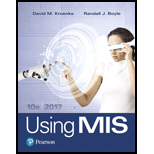
Using MIS (10th Edition)
10th Edition
ISBN: 9780134606996
Author: David M. Kroenke, Randall J. Boyle
Publisher: PEARSON
expand_more
expand_more
format_list_bulleted
Expert Solution & Answer
Chapter 2, Problem 2.3UYK
Explanation of Solution
Science exhibition project:
To accomplish any project, it is necessary to go through the four phases. They are:
- Starting phase: in this phase members of the team are required to brainstorm about the basic idea of the project and discuss about the basic items required to do it.
- Planning phase: in this phase members design the task list and divide the tasks such that each and every member is responsible for some task.
- Doing phase: in this phase members try to accomplish the task with which they are assigned, by using collaborative
information system . - Finalizing phase: in this phase members derive the best outcome by providing and accepting the critical feedback and revising the document accordingly.
Problem solving phase:
- During this phase members of the team try to solve the problems that were encountered in the project by discussing with each other.
- Group discussions are conducted in this phase as it is required to solve the problems collectively by using the knowledge and information that each and every member has about the project.
- In our team we listed the problems which were faced by each and every member, in different phases and then tried to solve them collectively.
Decision making phase:
- During this phase members of the team take some decisions that are beneficial for the accomplishment of the project.
- Decisions that are made are not taken solely, rather discussed everyone so that each and every member gets the chance to put forward his or her idea...
Expert Solution & Answer
Want to see the full answer?
Check out a sample textbook solution
Students have asked these similar questions
using r language
Write a function to compute a Monte Carlo estimate of the Beta(3,
3) cdf, and use the function to estimate F(x) for x = 0.1,0.2,...,0.9.
Compare the estimates with the values returned by the pbeta function
in R.
Write a function to compute a Monte Carlo estimate of the Gamma(r = 3, λ = 2) cdf, and use the function to estimate F(x) for x = 0.2, 0.4, . . . , 2.0. Compare the estimates with the values returned by the pgamma function in R.
Chapter 2 Solutions
Using MIS (10th Edition)
Ch. 2.6 - Prob. 1EGDQCh. 2.6 - Prob. 2EGDQCh. 2.6 - Prob. 3EGDQCh. 2.6 - Prob. 4EGDQCh. 2.7 - Prob. 1ACQCh. 2.7 - Prob. 2ACQCh. 2.7 - Prob. 3ACQCh. 2.7 - Prob. 4ACQCh. 2.7 - Prob. 5ACQCh. 2.9 - Prob. 1SGDQ
Ch. 2.9 - Prob. 2SGDQCh. 2.9 - Prob. 3SGDQCh. 2.9 - Prob. 4SGDQCh. 2.9 - Prob. 5SGDQCh. 2.9 - Prob. 2.1ARQCh. 2.9 - Prob. 2.2ARQCh. 2.9 - Prob. 2.3ARQCh. 2.9 - Prob. 2.4ARQCh. 2.9 - Prob. 2.5ARQCh. 2.9 - Prob. 2.6ARQCh. 2.9 - Prob. 2.7ARQCh. 2.9 - Prob. 2.8ARQCh. 2.9 - Prob. 2.9ARQCh. 2 - Prob. 2.1UYKCh. 2 - Using your experience working in past teams, give...Ch. 2 - Prob. 2.3UYKCh. 2 - Prob. 2.5CE2Ch. 2 - Prob. 2.6CE2Ch. 2 - Prob. 2.7CE2Ch. 2 - Prob. 2.8CE2Ch. 2 - Prob. 2.9CS2Ch. 2 - Prob. 2.1CS2Ch. 2 - Prob. 2.11CS2Ch. 2 - Prob. 2.12CS2Ch. 2 - Prob. 2.13CS2Ch. 2 - Prob. 2.14CS2Ch. 2 - Prob. 2.15CS2
Knowledge Booster
Similar questions
- using r languagearrow_forwardusing r languagearrow_forwardYou are given a class that processes purchases for an online store. The class receives calls to: • Retrieve the prices for items from a database • Record the sold items • Update the database • Refresh the webpage a. What architectural pattern is suitable for this scenario? Illustrate your answer by drawing a model for the solution, showing the method calls/events. b. Comment on how applying this pattern will impact the modifiability of the system. c. Draw a sequence diagram for the update operation.arrow_forward
- The images I have uploaded are the part 1 to 4 and questions below are continue on the questions uploaded 5. C++ Class Template with Method Stubs #pragma once #include <iostream> #include <string> #include <stdexcept> #include <vector> template <typename T> class HashTable { private: struct Entry { std::string key; T value; bool isOccupied; bool isDeleted; Entry() : key(""), value(), isOccupied(false), isDeleted(false) {} }; Entry* table; size_t capacity; size_t size; double loadFactorThreshold; size_t customHash(const std::string& key) const { size_t hash = 5381; for (char c : key) { hash = ((hash << 5) + hash) + c; } return hash; } size_t probe(const std::string& key, bool forInsert = false) const; void resize(); public: // Constructor HashTable(size_t initialCapacity = 101); // Big…arrow_forwardthis project is NOT for graded(marks) purposes, please help me with the introduction. give me answers for the project. i will include an image explaining everything about the project.arrow_forwardJava Graphics (Bonus In this lab, we'll be practicing what we learned about GUIs, and Mouse events. You will need to implement the following: A GUI with a drawing panel. We can click in this panel, and you will capture those clicks as a Point (see java.awt.Point) in a PointCollection class (you need to build this). The points need to be represented by circles. Below the drawing panel, you will need 5 buttons: O о о ○ An input button to register your mouse to the drawing panel. A show button to paint the points in your collection on the drawing panel. A button to shift all the points to the left by 50 pixels. The x position of the points is not allowed to go below zero. Another button to shift all the points to the right 50 pixels. " The x position of the points cannot go further than the You can implement this GUI in any way you choose. I suggest using the BorderLayout for a panel containing the buttons, and a GridLayout to hold the drawing panel and button panels. Regardless of how…arrow_forward
- also provide the number of moves(actions) made at state A and moves(actions) made state B. INCLUDE Java program required(this question is not graded)arrow_forwardYou are given a class that processes purchases for an online store. The class receives calls to: • Retrieve the prices for items from a database • Record the sold items • Update the database • Refresh the webpage a. What architectural pattern is suitable for this scenario? Illustrate your answer by drawing a model for the solution, showing the method calls/events. b. Comment on how applying this pattern will impact the modifiability of the system. c. Draw a sequence diagram for the update operation.arrow_forward2. The memory management has contiguous memory allocation, dynamic partitions, and paging. Compare the internal fragmentation and external fragmentation for these three approaches. [2 marks] 3. Suppose we have Logical address space = 24 = 16 (m = 4), Page size=2² =4 (n = 2), Physical address space = 26 = 64 (r = 6). Answer the following questions: [4 marks] 1) Total # of pages ? 2) Total # of frames ? 3) Number of bits to represent logical address? 4) Number of bits to represent offset ? 5) Number of bits to represent physical address? 6) Number of bits to represent a page number? 7) Number of bits to represent a frame number / 4. What is translation look-aside buffers (TLBS)? Why we need them to implement the page table? [2 marks] 5. Why we need shared pages for multiple processes? Give one example to show the benefits. [2 marks] 6. How to implement the virtual memory by using page out and page in? Explain with an example. [2 marks] 7. We have a reference string of referenced page…arrow_forward
- Good morning, please solve this trying to follow this criteria. (use Keil) Abstract describing the requirements and goals of the assignment. List file with no errors or warnings. Brief description of your implementation design and code. Debugging screen shots for different scenarios with your reference and comments. Conclusion (and please give me the code without errors, make sure it is working)arrow_forwardGood mrng, please solve this trying to follow this criteria. (use Keil) Abstract describing the requirements and goals of the assignment. List file with no errors or warnings. Brief description of your implementation design and code. Debugging screen shots for different scenarios with your reference and comments. Conclusion (and please give me the code without errors, make sure it is working)arrow_forward#include <stdio.h> #include <stdlib.h> #include <unistd.h> int global_var = 42; // int* function(int *a) { int local_var = 10; // *a = *a + local_var; int *local_pointer = (int *)malloc (size of (int) * 64); // Allocated array with 64 integers return local_pinter; } int main() { int local_main[1024*1024*1024*1024*1024] = {0}; // initialize an array and set all items as 0 int *heap_var = (int *)malloc(size of(int) * 16); // Allocated array with 16 integers *heap_var = 100; function(heap_var); printf(“the value is %d\n”, *heap_var); free(heap_var); // release the memory return 0; } 1) draw the memory layout of the created process, which should include text, data, heap and stack [2 marks]. 2) Indicate which section the variables are allocated [2 marks]: global_var local_var, local_pointer local_main heap_var, *heap_var (the data that it points to) 3) Does this code have memory leaking (heap memory is not released)? [2 marks] 4) The…arrow_forward
arrow_back_ios
SEE MORE QUESTIONS
arrow_forward_ios
Recommended textbooks for you
 Information Technology Project ManagementComputer ScienceISBN:9781337101356Author:Kathy SchwalbePublisher:Cengage Learning
Information Technology Project ManagementComputer ScienceISBN:9781337101356Author:Kathy SchwalbePublisher:Cengage Learning Principles of Information Systems (MindTap Course...Computer ScienceISBN:9781305971776Author:Ralph Stair, George ReynoldsPublisher:Cengage LearningCOMPREHENSIVE MICROSOFT OFFICE 365 EXCEComputer ScienceISBN:9780357392676Author:FREUND, StevenPublisher:CENGAGE L
Principles of Information Systems (MindTap Course...Computer ScienceISBN:9781305971776Author:Ralph Stair, George ReynoldsPublisher:Cengage LearningCOMPREHENSIVE MICROSOFT OFFICE 365 EXCEComputer ScienceISBN:9780357392676Author:FREUND, StevenPublisher:CENGAGE L Database Systems: Design, Implementation, & Manag...Computer ScienceISBN:9781305627482Author:Carlos Coronel, Steven MorrisPublisher:Cengage Learning
Database Systems: Design, Implementation, & Manag...Computer ScienceISBN:9781305627482Author:Carlos Coronel, Steven MorrisPublisher:Cengage Learning Database Systems: Design, Implementation, & Manag...Computer ScienceISBN:9781285196145Author:Steven, Steven Morris, Carlos Coronel, Carlos, Coronel, Carlos; Morris, Carlos Coronel and Steven Morris, Carlos Coronel; Steven Morris, Steven Morris; Carlos CoronelPublisher:Cengage Learning
Database Systems: Design, Implementation, & Manag...Computer ScienceISBN:9781285196145Author:Steven, Steven Morris, Carlos Coronel, Carlos, Coronel, Carlos; Morris, Carlos Coronel and Steven Morris, Carlos Coronel; Steven Morris, Steven Morris; Carlos CoronelPublisher:Cengage Learning Information Technology Project ManagementComputer ScienceISBN:9781285452340Author:Kathy SchwalbePublisher:Cengage Learning
Information Technology Project ManagementComputer ScienceISBN:9781285452340Author:Kathy SchwalbePublisher:Cengage Learning

Information Technology Project Management
Computer Science
ISBN:9781337101356
Author:Kathy Schwalbe
Publisher:Cengage Learning

Principles of Information Systems (MindTap Course...
Computer Science
ISBN:9781305971776
Author:Ralph Stair, George Reynolds
Publisher:Cengage Learning

COMPREHENSIVE MICROSOFT OFFICE 365 EXCE
Computer Science
ISBN:9780357392676
Author:FREUND, Steven
Publisher:CENGAGE L

Database Systems: Design, Implementation, & Manag...
Computer Science
ISBN:9781305627482
Author:Carlos Coronel, Steven Morris
Publisher:Cengage Learning

Database Systems: Design, Implementation, & Manag...
Computer Science
ISBN:9781285196145
Author:Steven, Steven Morris, Carlos Coronel, Carlos, Coronel, Carlos; Morris, Carlos Coronel and Steven Morris, Carlos Coronel; Steven Morris, Steven Morris; Carlos Coronel
Publisher:Cengage Learning

Information Technology Project Management
Computer Science
ISBN:9781285452340
Author:Kathy Schwalbe
Publisher:Cengage Learning